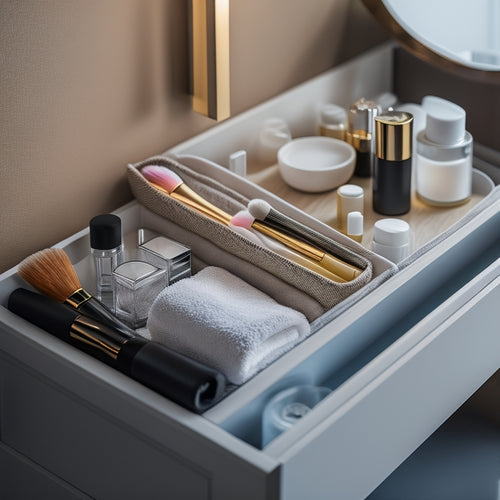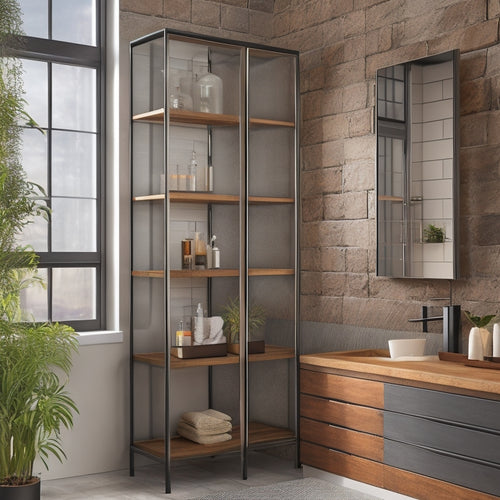
Installing a Sink in the Toilet
Share
When installing a sink in your toilet, start by selecting the right sink type, considering materials like porcelain, ceramic, or stainless steel, and ensuring it complements your existing fixtures. Precise measurements are vital, so take note of the toilet's width, length, and height, as well as obstructions like pipes and handles. Turn off the water supply lines, then disconnect old toilet fittings and clean the installation area. You'll need to install sink mounting hardware, connect water supply lines, and test for leaks and issues. With these steps complete, you're ready to move forward with the process, and attention to detail will be essential in achieving a successful and functional installation.
Key Takeaways
- Choose the right sink type considering materials, aesthetic, and maintenance needs to ensure a successful installation.
- Accurately measure the toilet space, accounting for obstructions and distance measurements to ensure a proper fit.
- Turn off the water supply lines by locating and rotating shut-off valves clockwise before starting the installation.
- Secure the sink mounting hardware, ensuring a watertight seal with silicone caulk or epoxy, and consider the sink's weight.
- Test for leaks and issues by turning on the water supply, visually inspecting connections, and utilizing leak detection tools.
Choosing the Right Sink Type
When planning to install a sink in the toilet, selecting the right sink type is essential to guarantee a functional and efficient system. You'll want to take into account sink materials that fit your needs. Porcelain, ceramic, and stainless steel are popular options, each with their own benefits.
Porcelain sinks are durable and resistant to stains, while ceramic sinks offer a glossy finish and ease of cleaning. Stainless steel sinks, on the other hand, are budget-friendly and easy to maintain.
Aesthetic factors also play a significant role in your decision. Think about the overall style you want to achieve in your toilet. Do you prefer a modern, sleek look or a more traditional, ornate design?
The sink type you choose should complement the existing fixtures and color scheme. Additionally, take into account the sink's shape and size. Will a compact sink fit better in your toilet, or do you need a larger one to accommodate multiple users?
Measuring Toilet Space Correctly
You've selected the perfect sink type for your toilet, now it's time to make certain it fits seamlessly into the existing space. Measuring the toilet space correctly is essential to avoid installation challenges and guarantee ideal space optimization.
Take precise measurements of the toilet's width, length, and height to determine the maximum size of the sink that can fit. Don't forget to account for any obstructions, such as pipes or toilet handles, that may affect the sink's placement.
Use a tape measure to record the distance between the toilet's centerline and the wall, as well as the distance from the floor to the top of the toilet bowl. Compare these measurements to the sink's dimensions to assure a snug fit.
If you're planning to install a wall-mounted sink, measure the distance between the wall studs to determine the best placement. Remember, accurate measurements are key to a successful installation, so take your time and double-check your numbers.
With precise measurements, you'll be well on your way to a sink that fits like a glove in your toilet.
Turning Off Water Supply Lines
You'll need to identify the shut-off valves for the toilet's water supply lines, typically located near the floor or wall behind the toilet.
Next, locate the water supply lines themselves, which connect the shut-off valves to the toilet.
Check the valve handles to confirm they're in the "off" position, ready for you to proceed with the installation.
Identify Shut-Off Valves
Every home has multiple shut-off valves controlling the water supply lines, and finding the right ones is essential to successfully installing a sink in the toilet.
You'll need to identify the shut-off valves that control the water supply to the toilet, as well as any other valves that might affect the installation process.
To do this, you'll need to get familiar with your home's plumbing layout.
- Check behind the toilet and under the sink to spot any visible valves.
- Look for valves near the water supply lines, which are usually copper or PEX pipes.
- Check your basement or crawl space for valves that control the main water supply lines.
- Consult your home's plumbing diagram or blueprints, if available.
When you've identified the right shut-off valves, make sure to turn them clockwise to shut off the water supply.
This will prevent any water from flowing during the installation process, giving you a safe and mess-free environment to work in.
With the right valves turned off, you can focus on exploring sink design options and selecting the best plumbing materials for your unique project.
Locate Water Supply Lines
The toilet's water supply lines, typically copper or PEX pipes, are usually located near the floor and connected to the toilet's fill valve or float assembly.
Now, you'll need to identify which lines supply water to the toilet and which ones can be repurposed for your sink installation. Take a closer look at the pipes and note their sizes, materials, and connections. You might need to adjust your sink placement depending on the water supply line configuration.
Turn off the water supply to the toilet by locating the shut-off valves you identified earlier. You should hear the water pressure drop as the water flow stops.
Open the toilet's tank to drain the remaining water. With the water supply lines isolated, you can now inspect them more closely. Check for any signs of corrosion, mineral buildup, or damage that could affect water pressure or flow.
Make note of any repairs or replacements needed before proceeding with your sink installation.
Check Valve Handles
Now that you've isolated the water supply lines, it's time to focus on the valve handles that control the water flow. These handles are connected to check valves, which are essential for maintaining water pressure and preventing backflow. To guarantee check valve functionality, you'll need to turn the handles clockwise to shut off the water supply.
Here are a few things to keep in mind when dealing with check valve handles:
-
Make certain to turn the handles slowly and deliberately to avoid damaging the valve or surrounding pipes.
-
Check valve maintenance is key, so be sure to inspect and clean the valves regularly to prevent mineral buildup and corrosion.
-
Don't overtighten the handles, as this can damage the valve stem or surrounding threads.
- If you're having trouble turning the handles, don't force it – you may need to replace the valve or seek professional assistance.
Disconnecting Old Toilet Fittings
Because you're replacing the toilet with a sink, you'll need to disconnect the old toilet's water supply lines and drainpipes. These fittings have been holding on for dear life, but it's time to bid them adieu.
Use an adjustable wrench to loosen the nuts holding the water supply lines in place. Once loose, you should be able to remove them by hand.
Next, focus on the drainpipes. You'll need to disconnect the toilet flange from the floor drain. This might require a bit of elbow grease, so be prepared to get a little messy.
After removing old fittings, cleaning the installation area is essential. You don't want any leftover grime or debris interfering with your sink installation.
Use a wire brush to scrub away any corrosion or buildup on the floor drain and surrounding area. Follow up with a mop or wet vacuum to remove any remaining dirt or dust.
With the area sparkling clean, you'll be ready to move on to the next step in your sink installation process.
Installing Sink Mounting Hardware
You'll need to select the appropriate mounting hardware for your sink installation, choosing from options like clips, clamps, or adhesive-based systems.
Next, you'll secure the sink to the toilet using a fitting method that guarantees a watertight seal, such as silicone caulk or epoxy.
Mounting Hardware Types
Sink mounting hardware is a critical component of the installation process, as it secures the sink to the toilet and guarantees a watertight seal.
You're probably thinking, "What kind of mounting hardware do I need?" Well, you've got options!
When it comes to mounting materials, you'll encounter:
- Stainless steel clips: corrosion-resistant and easy to install
- Aluminum brackets: lightweight and perfect for smaller sinks
- Brass mounting rings: durable and suitable for heavy-duty use
- Adhesive-backed foam strips: a great option for non-traditional sink installations
Each type of mounting hardware has its own installation techniques and benefits.
As you choose the right one for your sink, keep in mind the specific requirements of your toilet and the weight of your sink.
Secure Fitting Methods
Around the toilet's rim, a secure fitting is essential to prevent water seepage and guarantee a sturdy connection.
You'll want to choose fitting materials that can withstand the constant exposure to water and humidity. Look for materials like stainless steel, brass, or high-quality plastics that can resist corrosion and damage.
When it comes to installation tools, you'll need a few trusty sidekicks to get the job done. A wrench or pliers will come in handy for tightening those pesky mounting bolts.
Don't forget a level to verify your sink is perfectly aligned with the toilet rim. You might also need some silicone sealant or putty to create a watertight seal.
To secure the sink, start by applying a thin layer of sealant around the rim.
Next, carefully lower the sink into place, making sure it's centered and even. Use your installation tools to tighten the mounting bolts in a star pattern, working your way around the rim.
Drainage System Connection
As you move on to the next crucial step, connecting the drainage system is paramount to guaranteeing a leak-free and efficient toilet-sink combo. This is where things can get a bit messy, but don't worry, with the right tools and a clear understanding of the process, you'll be just fine.
Here are some key considerations to keep in mind:
-
Drainage Pipe: Verify the pipe is sloped correctly to prevent water from flowing back into the sink. A minimum slope of 1/4 inch per foot is recommended.
-
Venting Requirements: Don't forget to vent your drainage system to allow air to enter and prevent siphoning. Check your local plumbing codes for specific requirements.
-
Waste Line Connection: Connect the sink's waste line to the toilet's waste line, making sure to secure it with the appropriate fittings and adhesives.
- Pipe Materials and Fixture Placement: Choose pipe materials that meet local plumbing codes, and verify the sink is installed at a comfortable height for users.
Remember to follow local plumbing codes and take necessary safety precautions when working with installation tools and accessing tight spaces.
With these tips in mind, you'll be well on your way to a successful drainage system connection.
Connecting Water Supply Lines
Your toilet's water supply lines must be connected to the shut-off valves, which are typically located near the toilet. Make certain to turn these valves clockwise to shut off the water supply before proceeding.
You'll need to connect the water supply lines to the sink's faucet, confirming they're compatible with your sink materials. For instance, if you have a copper sink, you'll need copper-friendly supply lines.
Next, attach the supply lines to the shut-off valves, making certain they're securely fastened. Don't overtighten, as this can damage the valves or lines.
Now, turn the shut-off valves counterclockwise to restore water pressure. Check for any signs of leakage around the connections.
Remember to test the water pressure by turning on the faucet. A gentle flow should emerge. If it's too weak or strong, adjust the shut-off valves accordingly.
Testing for Leaks and Issues
With the water supply lines connected, you're ready to test for leaks and issues. This vital step guarantees your sink-in-toilet installation doesn't turn into a water-logged nightmare.
Turn on the water supply and check for leaks at the connections, faucets, and drain assembly. Don't be that person who finds a leak after the fact – it's a real sink-er (get it?).
To identify leaks, use these methods:
- Inspect visually: Look for signs of moisture, water droplets, or mineral deposits around connections.
- Listen carefully: Pay attention to unusual sounds, like hissing or gurgling, that might indicate a leak.
- Feel for wetness: Run your hand along the pipes and connections to detect any water seepage.
- Use leak detection tools: Invest in a leak detector or a pressure test kit to identify hidden issues.
Final Touches and Adjustments
Now that you've confirmed your sink-in-toilet installation is leak-free, it's time to focus on the finishing touches. You're almost done, but don't rush through this part – it's essential to guarantee your sink looks and functions flawlessly.
First, inspect the sink aesthetics. Check for any scratches, dents, or misaligned components. Make any necessary adjustments to the faucet, drain, or mounting hardware. You want your sink-in-toilet to look sleek and professional, not like a DIY experiment gone wrong.
Next, consider maintenance tips to prevent future issues. Regularly clean the sink and toilet to prevent mineral buildup and clogs. Check the water supply lines and drain connections for signs of wear or damage.
Frequently Asked Questions
Can I Install a Sink in My Toilet if I'm Not a Plumber?
You're brave to contemplate DIY sink installation, but let's get real - if you're not a plumber, you'll face sink installation challenges. Follow trusted DIY plumbing tips to avoid flooding your bathroom, and maybe, just maybe, you'll succeed without calling a pro.
How Do I Clean the Area Around the Toilet During Installation?
Break out your medieval sword and slay the grime! Before installation, you're scrubbing the toilet area like a pro - don't forget those hidden crevices. Use a toilet brush, disinfectant, and microfiber cloth to guarantee a sparkling clean surface for a seamless installation.
What Tools Do I Need to Disconnect the Old Toilet Fittings?
You'll need a trusty adjustable wrench, a basin wrench for those hard-to-reach fittings, and possibly a pipe wrench to tackle corroded connections when disconnecting old toilet fittings - don't forget to have plumbing-specific tools, like a faucet key, handy for a smooth process.
Are There Any Specific Safety Precautions I Should Take During Installation?
Are you ready to plunge into a world of plumbing hazards? You should be! When tackling any plumbing project, you're wise to take specific safety precautions, like wearing personal protective gear, to avoid getting flushed by unexpected surprises.
Can I Install a Sink in a Toilet in a Rented Apartment or House?
Before you start drilling, check your rental agreement for sink installation restrictions; if it's not explicitly stated, you'll need to get permission from your landlord, as rental regulations can be quirky, and you don't want to flush your deposit down the drain.
Conclusion
You've successfully installed a sink in your toilet! Remember, "measure twice, cut once" - a mantra that's especially essential in plumbing projects. By following these steps, you've guaranteed a secure and leak-free installation. Double-check your connections, and don't hesitate to make adjustments as needed. With your new sink in place, you're ready to enjoy the convenience and space-saving benefits it provides.
Related Posts
-

Modern Bathroom Drawer Organizers With Dividers
Modern bathroom drawer organizers with dividers help you make the most of your space and keep your essentials tidy. T...
-

Tall Industrial Bathroom Cabinet for Narrow Spaces
A tall industrial bathroom cabinet is your solution for narrow spaces, combining style with practicality. It reaches ...
-

Effortlessly Organize Your Bathroom With Free Labels
Effortlessly organize your bathroom with free labels by prioritizing style, functionality, and clutter-free living. C...


